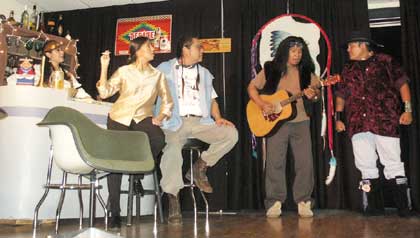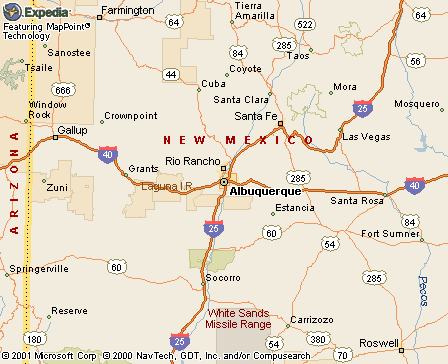|
|
Canku Ota |
|
|
(Many Paths) |
||
|
An Online Newsletter Celebrating Native America |
||
|
February 7, 2004 - Issue 106 |
||
|
|
||
|
'Evening at the
Warbonnet' |
||
|
by Rick Abasta - The
Navajo Times
|
||
|
credits: The
play 'Evening at the Warbonnet' featured a talented all-native cast,
including, left to right, Mable (Cami' Leonard), Artsy (John Gates),
Ki (Kelly Byars) and Brave Eagle (Ernest David Tsosie III), who
discussed the conditions of their souls before crossing the river
to the afterlife during a performance Saturday at the Indian Pueblo
Culture Center Albuquerque. (Times photo - Rick Abasta)
|
|
On Saturday night, a predominately native audience that attended a performance of "Warbonnet" left the Indian Pueblo Cultural Center with an understanding of our brief time available on earth. "Evening at the Warbonnet" featured a talented all-native cast: Kelly Byars, Mirielle Begay, John Gates, Cami' Leonard, Ernest David Tsosie III and Andrea Lujan. The play was written by Bruce King (Oneida). The Warbonnet is an Indian bar like any located all over Indian Country. People go there to "drown their sorrows" and "cry the blues." The play is based on the Anishinaabe (Ojibway) belief that people must cleanse their souls before crossing the river to the afterlife. King wrote the play over 10 years ago during a turbulent time of his life. "I wrote ('Evening at the Warbonnet') in 1989. It's kind of an old piece. I was laid off from work and I was living in Buffalo, N.Y. on unemployment," King recalled. "It was one of those times in life where you say, 'Where did it all go?'" A veteran of the Vietnam War, King spent three years in the U.S. Army with the 24th Medivac Company in Nha Trang, Vietnam. "Evening at the Warbonnet" resonates with some of the atrocities of the war. Like most of the plays he's penned, "Evening at the Warbonnet" is steeped in native culture clashing with contemporary times. The play premiered in 1994 at the Institute of American Indian Arts in Santa Fe. "The whole thing is really about truth and denial. I just tell the stories," King said. King said he's been to bars called the Warbonnet in Wisconsin and Chicago. However, the intimate knowledge he had of the Chicago Warbonnet may have been the basis for his play. "In Chicago (the Warbonnet) was right next store to a daily work/daily pay place called Ready Men. It was a real dive, a real bucket of blood," King recalled. For the play, the Warbonnet is like purgatory where patrons must expunge their sins before crossing the river into salvation to stand before the Creator. The secrets each character held onto with clenched fists gave the play an eerie, stark reality that chilled many in the audience. King said the play has been in production in many places, particularly tribal colleges, across the country. "We're so aggravated by current things that it's hard to tell human beings to be good," King said. His ability to tell the issues of humanity through the characters in his plays has made King a popular native playwright with native actors. Cami' Leonard, a Navajo actress who played the role of Mable, said "Evening at the Warbonnet" was the most unique play she had ever read by a native playwright. Instantly drawn to the play, Leonard said she wanted to be a part of the production. "Mable was definitely a challenge for me as an actor. She was loud, tipsy, a comedian and aggressive. These were characteristics that I didn't see strong in myself," Leonard said. For 10 years Leonard has acted in plays and films, most notably "Coyote Waits" where she was cast as Delbert Tsosie's widow in the latest Hillerman novel adapted to film. Kelly Byars (Choctaw) played the role of Ki and said his character was one who liked to joke. "Ki is a coyote, first of all. He is the trickster that lies in us all. He is the type that is single and not afraid of anything, or anybody," Byars said. He said the similarities between the character of Ki and his real identity is that they both like to joke and hear people laugh. "Yet, I'm not a trickster - Coyote is!" Byars said. His interest in film began in 1993, when he was a boom operator for the Kickboxer IV set in Galesteo, N.M. In 2000, Byars produced a film, "The Backroad," and played the lead role. Since then, he has been in five theatre productions through the University of New Mexico and the Words of Fire Festival in Albuquerque. With the completion of nine short feature films and one documentary, Byars has become prolific in ways he never imagined. John Gates (Cheyenne River Sioux), who played the role of Artsy in "Warbonnet" said he was blown away by the script and story line. "What I love about the play is its honesty, the way that Bruce has captured on stage what many native folk feel," Gates said. "Bruce is an outstanding artist. What can I say, I'm gushing with pride that I had the opportunity to work with him," he said. Tazbah McCullah, marketing/advertising director for the Indian Pueblo Cultural Center, said "Evening at the Warbonnet" was recommended to the center by Maria Williams, director of Arts of the Americas at UNM. "We want to be the venue for Indian theater in Albuquerque," McCullah said. "Evening at the Warbonnet" sold out for the show and a standing room only crowd watched the play intently. |
|
|
www.expedia.com |
|
|
||
|
|
||
| Canku Ota is a free Newsletter celebrating Native America, its traditions and accomplishments . We do not provide subscriber or visitor names to anyone. Some articles presented in Canku Ota may contain copyright material. We have received appropriate permissions for republishing any articles. Material appearing here is distributed without profit or monetary gain to those who have expressed an interest. This is in accordance with Title 17 U.S.C. Section 107. | ||
|
Canku Ota is a copyright © 2000, 2001, 2002, 2003, 2004 of Vicki Lockard and Paul Barry. |
||
 |
 |
|
|
The "Canku Ota - A Newsletter Celebrating Native America" web site and its design is the |
||
|
Copyright © 1999, 2000, 2001, 2002, 2003, 2004 of Paul C. Barry. |
||
|
All Rights Reserved. |
||
 ALBUQUERQUE
- Attending a play can be a visceral, moving experience. This is
especially true for the native play "Evening at the Warbonnet,"
which tackles the controversial issues of suicide, drug abuse, AIDS,
murder and narcissism in one fell swoop.
ALBUQUERQUE
- Attending a play can be a visceral, moving experience. This is
especially true for the native play "Evening at the Warbonnet,"
which tackles the controversial issues of suicide, drug abuse, AIDS,
murder and narcissism in one fell swoop.